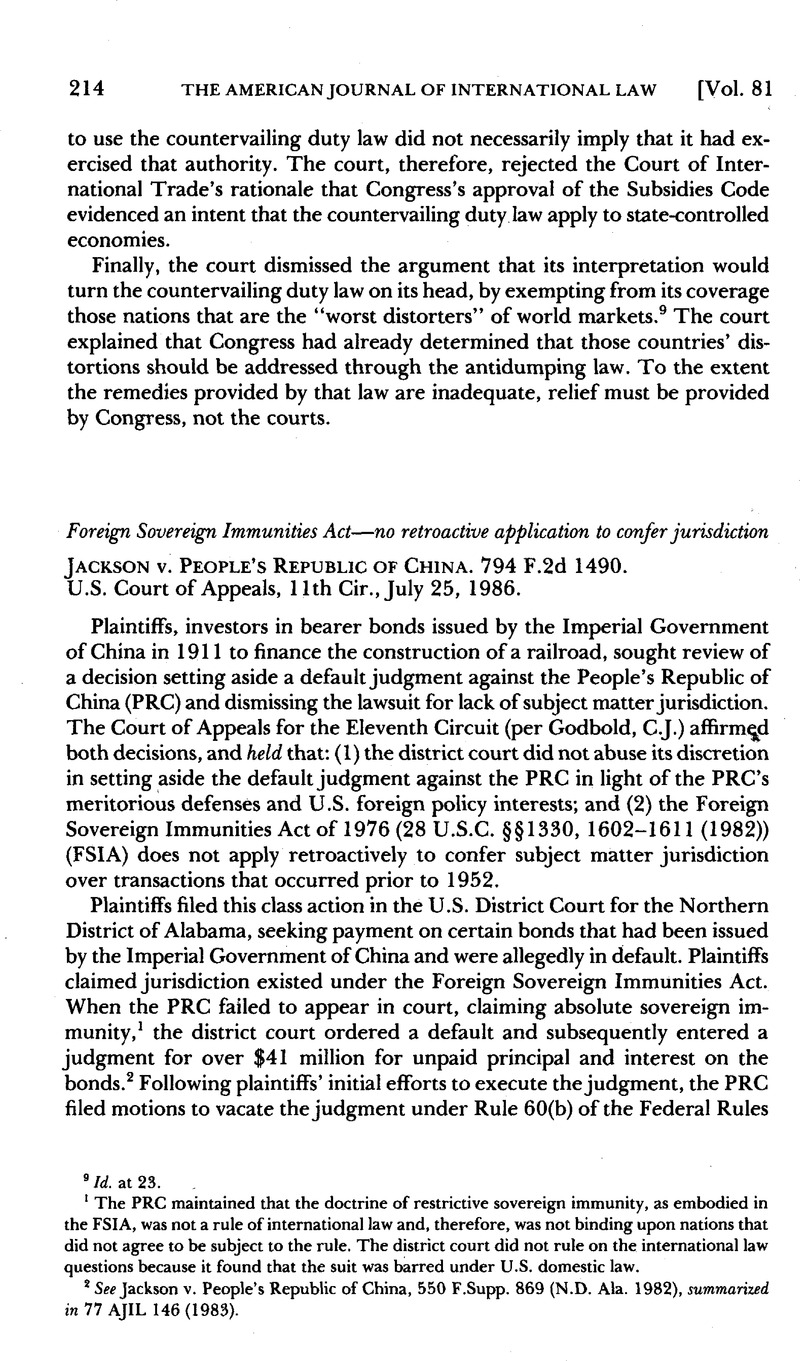No CrossRef data available.
Article contents
Jackson v. People’s Republic of China
Published online by Cambridge University Press: 27 February 2017
Abstract

- Type
- Judicial Decisions
- Information
- Copyright
- Copyright © American Society of International Law 1987
References
1 The PRC maintained that the doctrine of restrictive sovereign immunity, as embodied in the FSIA, was not a rule of international law and, therefore, was not binding upon nations that did not agree to be subject to the rule. The district court did not rule on the international law questions because it found that the suit was barred under U.S. domestic law.
2 See Jackson v. People’s Republic of China, 550 F.Supp. 869 (N.D. Ala. 1982), summarized in 77 AJIL 146 (1983).
3 The PRC sought dismissal under Rule 60(b), subparagraphs (1), (4) and (6), which state:
On motion and upon such terms as are just, the court may relieve a party or his legal representative from a final judgment, order, or proceeding for the following reasons: (1) mistake, inadvertence, surprise, or excusable neglect; . . . (4) the judgment is void; . . . (6) any other reason justifying relief from the operation of the judgment.
4 The PRC did not appear at the district court. The Departments of State and Justice filed two statements of interest in support of the PRC’s motions and representatives of the U.S. Government were present at the district court, but did not participate.
6 See Jackson v. People’s Republic of China, No. 79-C-1272-E (N.D. Ala. Feb. 27, 1984), summarized in 78 AJIL 675 (1984).
6 See Jackson v. People’s Republic of China, 596 F.Supp. 386 (N.D. Ala. 1984), summarized in 79 AJIL 456 (1985).
7 On appeal, the PRC filed a brief but did not present oral argument. The United States filed a statement of interest and argued before the appellate court. Plaintiffs’ motion for a rehearing was denied. 801 F.2d 404 (11th Cir. 1986) (en banc).
8 794 F.2d 1490, 1496.
9 Prior to 1952, U.S. courts granted foreign sovereigns complete immunity from suit if so requested by the State Department. In 1952, the State Department issued the “Tate letter,” which adopted the restrictive theory of foreign sovereign immunity, limiting sovereign immunity to suits involving public activities. After the Tate letter was issued, courts granted sovereign immunity either in response to suggestions by the State Department or on their own initiative where foreign governments failed to ask the State Department to intervene. In 1976, Congress passed the FSIA to clarify the standards of restrictive sovereign immunity, to free the Government from diplomatic pressures and to place the jurisdictional determination squarely in the hands of the courts. See Verlinden B.V. v. Central Bank of Nigeria, 461 U.S. 480, 488 (1983).
10 794 F.2d at 1498.
11 See Yessenin-Volpin v. Novosti Press Agency, 443 F.Supp. 849 (S.D.N.Y. 1978). The Eleventh Circuit distinguished this case on the basis that the court did not address the jurisdictional aspects of the FSIA, but rather applied the substantive law of foreign sovereign immunity that is embodied in the FSIA. See 794 F.2d at 1498.
12 But see Corporacion Venezolana de Fomento v. Vintero Sales, 629 F.2d 786 (2d Cir.), cert, denied, 449 U.S. 1080 (1980) (court found “henceforth” language in FSIA applied to substantive immunity provisions and not to jurisdictional provisions).
13 Plaintiffs argued that the bonds were renegotiated in 1937 and matured in 1976. Plaintiffs failed to claim retroactivity only back to 1952, however, insisting that “[t]he act is either retroactive or it is not.” 794 F.2d at 1499 (quoting Appellants’ Reply Brief at 31).




